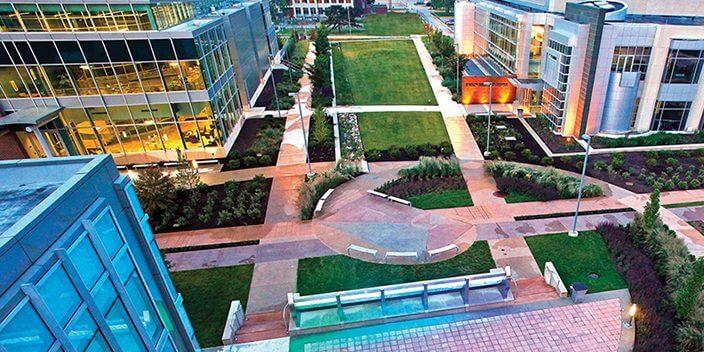July 25, 2022
Purdue expands leading interdisciplinary research with comprehensive innovation hub

WEST LAFAYETTE, Ind. — As the skyline grows higher on the west side of campus, so do the energy and enthusiasm around Purdue University’s growing interdisciplinary research enterprise aimed at delivering solutions for the world’s most critical problems.
The expansion of Discovery Park District to include the renowned research units of Discovery Park demonstrates Purdue’s ongoing commitment to stay at the forefront of research and technology transfer through partnerships with industry and government.
The decision by Purdue President Mitch Daniels and the Purdue Board of Trustees to expand Discovery Park District also draws attention to the considerable passage of time since Discovery Park was established. What began with a first-of-its-kind interdisciplinary building for nanotechnology research in 2001 quickly grew, with two Lilly Endowment grants that totaled over $50 million and other significant support from the state and private sources, to include six more buildings to support major interdisciplinary initiatives and Indiana’s economic development. By 2014, Discovery Park reached the $1 billion milestone in external sponsored research, private gifts and endowments.
The following Discovery Park facilities, all of which enable cutting-edge research and innovation, now bring their infrastructure and interdisciplinary expertise to Purdue’s innovation district while continuing to serve as a vital resource to the University’s campuswide research enterprise. Many are also open to industry and outside users who wish to leverage state-of-the-art instruments and techniques at Purdue.
- Birck Nanotechnology building
- Scifres Nanofabrication Laboratory, one of the largest academic clean rooms in the nation
- Bindley Bioscience building
- Burton D. Morgan Innovation and Entrepreneurship building
- Gerald D. and Edna E. Mann Hall
- Hall for Discovery and Learning Research
- Drug Discovery building
- Flex Lab
These buildings, facilities and labs support research in areas such as:
- Nanotechnology, including electronics, spintronics and photonics; quantum sensing and computing; printed electronics; and nanomedicine.
- Health sciences, including cancer, inflammation, immunology and infectious disease; neuroscience; health care systems and health equity; analytical instrument development and translation; global health.
- Discovery, synthesis, testing, clinical translation, and advanced manufacturing of new drugs for diagnosis and therapy of diseases.
- Sustainable future, including the food-energy-water nexus; food and nutrition security; water resources; chemical and environmental exposures; climate and extreme weather prediction and mitigation; environmental policy and justice.
- Energy transition, including decarbonization of manufacturing processes and transportation systems; low-carbon and renewable energy sources; circular economies; energy and technology policy.
- National security and defense, including hypersonics, microelectronics, energetic materials, cyberphysical systems and security, autonomous systems, advanced materials and manufacturing.
- Data science, AI and cybersecurity, including theory and applications in biological, agricultural, social and engineered systems.
- Innovation, entrepreneurship, commercialization and partnership programs.
Each of these hubs of interdisciplinary research remains a resource for researchers campuswide and will be organized centrally within the Office of the Executive Vice President for Research and Partnerships.
“Discovery Park was launched as a unique innovation community that brings together researchers from across disciplines and sectors to work together in state-of-the-art facilities to solve grand societal challenges,” said Theresa Mayer, executive vice president for research and partnerships. “This cross-cutting approach to research has led to significant growth in major interdisciplinary centers of excellence funded by federal agencies and industry. By including our leading interdisciplinary capabilities in Discovery Park District, we are strengthening our innovation ecosystem and providing additional opportunities for collaboration with industry, government lab, and venture investors.”
Throughout its decades as the umbrella organization for Purdue’s interdisciplinary research centers and institutes, Discovery Park’s success stemmed from its dedication to advancing large-scale research across disciplines and moving research from the lab to the marketplace. It also provided development opportunities for early career faculty and researchers at Purdue and provided valuable collaborations, workshops and training opportunities.
“As the central hub for Purdue’s interdisciplinary research and translation, Discovery Park District will continue to grow productive relationships with innovative and high-growth companies by providing daily access to Purdue’s world-class talent and advanced R&D facilities,” Mayer said. “It will continue to advance Purdue’s reputation as a university eager to address their most pressing challenges.”
The innovation district also takes in 400 acres just west of campus focused on aerospace and defense, life sciences and animal health, agriculture-related technology and innovation, and advanced manufacturing. It includes the Convergence Center for Innovation and Collaboration, Purdue University Airport, Maurice J. Zucrow Laboratories, and Purdue Technology Center Aerospace (Rolls-Royce), in addition to corporate partner facilities, including Saab and Schweitzer Engineering Laboratories. Also contributing to the “live, work and play community” within Discovery Park District are multiple housing options and space for commercial development.
“Discovery Park District has become something greater than initially imagined,” said Brian Edelman, president of the Purdue Research Foundation, which supports the innovation district’s extensive efforts to deliver research solutions. “Today we have a much larger district that is now a live, work and play community. The three-acre mixed-used area called Continuum offers space for commercial development and 250 apartments. Provenance is a multiphase plan that will provide townhomes, apartments and single-family homes, among other amenities when completed. Ascension St. Vincent will begin construction this summer on a neighborhood hospital that will provide inpatient and emergency care within West Lafayette for the first time.”
Writers: Amy Raley, araley@purdue.edu
Rhianna Wisniewski, rmwisnie@purdue.edu
Source: Theresa Mayer, tsmayer@purdue.edu
